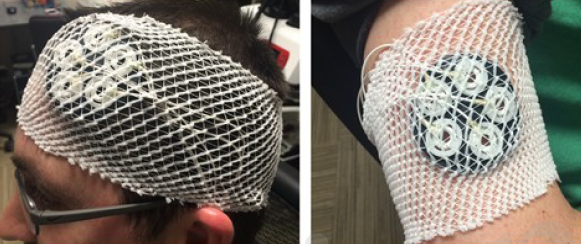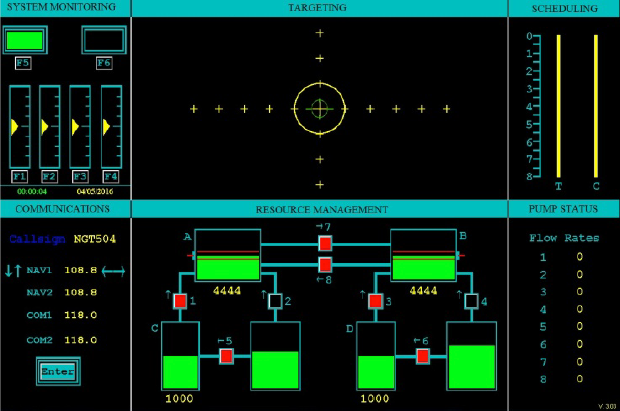Test of transcranial direct current stimulation (tDCS) of the brain shows improved multitasking performance
November 15, 2016

Placement of five anode electrodes (left) over the dorsolateral prefrontal cortex and the cathode (right) over the right shoulder (to avoid spurious cognitive effects from cortical excitability) (credit: Justin Nelson et al./ Front. Hum. Neurosci.)
In an experiment at the Air Force Research Laboratory, Wright-Patterson Air Force Base in Ohio, researchers* have found that transcranial direct-current stimulation (tDCS) of the brain can improve people’s multitasking skills and help avoid the drop in performance that comes with information overload.
The study was reported in a pre-publication paper in the open-access journal Frontiers of Human Neuroscience. It was motivated by the observation that various Air Force operations such as remotely piloted and manned aircraft operations require a human operator to monitor and respond to multiple events simultaneously over a long period of time. “With the monotonous nature of these tasks, the operator’s performance may decline shortly after their work shift commences,” according to the researchers.
The study set out to determine at what baud rate (difficulty level) improved multitasking throughput capacity kicks in and whether tDCS can improve performance, resulting in higher throughput capacity. The researchers used a common stimulation site for augmenting cognitive function via tDCS: the left dorsolateral prefrontal cortex (DLPFC), which has been associated with working memory, attention, vigilance, planning, and reasoning.**
Multitasking test

User interface of the multitasking Multi-Attribute Task Battery (MATB) (credit: Justin Nelson et al./ Front. Hum. Neurosci.)
The Air Force multi-attribute task battery (AF-MATB), based on the MATB multitasking test developed by NASA, requires the human operator (or experimental subject) to simultaneously monitor and respond to four independent tasks — systems monitoring, communication, targeting and resource management — on one computer screen.
There were 20 participants in the test, split evenly between experimental and control groups. The experimental group received 2mA of tDCS for a duration of 30 minutes. To emulate the subjective skin sensations present in active tDCS, the control group received sham stimulation at 2mA for only 30 seconds.
For example, the systems monitoring task (upper left) involved monitoring the two lights (rectangles), keeping the left light in the on status (displaying green) and the right light in the off status (displaying black). The triangular yellow markers shifted randomly towards the top or the bottom of the dial and began oscillating around a new location. When this event occurred, participants were to select the corresponding F1–F4 keys to reset the dials.
Augmented multitasking
The total input began at 0.6 bits/s and increased to 2.2 bits/s by a factor of 0.2 bits/s every four minutes. The study found that with tDCS stimulation, the subject’s multitasking throughput (or channel capacity) plateaued (maxed out) at 2.0 bits/s input, whereas the control group (no stimulation) plateaued near 1.3 bits/s, showing that tDCS had the ability to augment and enhance multitasking throughput by a factor of 1.5 in this experiment.
The finding potentially has important implications for high-workload environments that provide information to the operator via a wide range of stimuli. Additional research may be conducted to evaluate the robustness of these observed effects.
However, as reported by KurzweilAI, a recent open letter by 39 neuroscience researchers, published in the Annals of Neurology, warns that “outcomes of tDCS can be unpredictable … the benefits that are seen after tDCS in certain mental abilities may come at the expense of others.”
* Human factors engineers at the Wright State University Department of Biomedical, Industrial and Human Factors Engineering were also involved in the research.
** The left dorsolateral was selected as the stimulation site because this region of the brain is associated with sustained attention, working memory, decision making, planning and reasoning which are all directly involved with multitasking. The left DLPFC was chosen instead of the right DLPFC to enhance performance by right-handed participants, but stimulation of the right DLPFC may also influence working memory performance, according to the researchers.